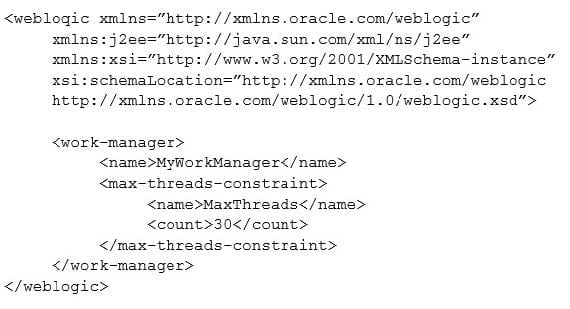1Z0-134 Online Practice Questions and Answers
You are asked to configure Node Manager for your production environment. You are considering whether to use the Java version or the script-based version of Node Manager.
Which statement correctly describes the difference between the two versions?
A. If you are installing WebLogic Server on a Windows system, you must use the Java version of Node Manager.
B. The script-based version of Node Manager can be used in conjunction with inetd on supported UNIX systems.
C. The script-based version of Node Manager requires a larger footprint than the Java version.
D. When Node Manager is used for consensus leasing, you may see faster performance with the script-based version.
A Web Module needs specific tuning. The Development team fine tunes the module in the deployment descriptor (weblogic.xml) as follows:

Which two are true? (Choose two.)
A. MyWorkManager is an application-scoped Work Manager.
B. Add the line
C. MyWorkManager is a Global Work Manager.
D. MyWorkManager is a Default Work Manager.
E. Once the application is deployed and started on a Managed WebLogic Server, MyWorkManager will appear under Environment/Work Managers on the WebLogic Console.
You are analyzing the JMSDeliveryMode header field for all the messages for all the queues deployed to your JMSServer.
Which two values do you expect to find for this header? (Choose two.)
A. PERSISTENT
B. NON_PERSISTENT
C. TRANSIENT
D. PERMANENT
E. MULTIMODE
F. EXACTLY_ONCE
We find the JMSRedelivered header set for a particular message on the receiver.
In which two scenarios is this expected to happen? (Choose two.)
A. The application has already received the message, but did not acknowledge it.
B. The session's recover() method was called to restart the session beginning after the last acknowledged message.
C. The sender calls the redeliver() method for the message.
D. The sending application crashes after sending the message.
Your development team is considering several different types of new applications. You have been asked to advise them concerning which types can be deployed in WebLogic Server leveraging the Production Redeployment feature. Which application deployment type is NOT supported for Production Redeployment? (Choose the best answer.)
A. enterprise applications (EAR) that contain a Coherence Grid Archive (GAR) module
B. web service applications that are conversational or that use reliable messaging
C. standalone Enterprise Java Bean (EJB) applications
D. enterprise applications (EAR) that are accessed by inbound JMS messages
Under a normal startup scenario, a managed server contacts the administration server to get its configuration information.
However in case the administration server is not available, which mechanism can be used by the managed server to start up successfully? (Choose the best answer.)
A. Silent Mode
B. Isolated Mode
C. MSI Mode
D. Cluster Mode
You created a user and group using the WebLogic Server default authentication provider.
Where are these principals stored? (Choose the best answer.)
A. the WebLogic Server OPSS jps-config.xml security store
B. the WebLogic Server embedded LDAP server
C. the WebLogic Server embedded database security store
D. the default jazn-data.xml file-based security store
You are required to configure SSL for an instance of WebLogic Server in a production environment. You have already created your self-signed certificate within the myKeyStore.jks keystore. You must now obtain a new digital certificate from a trusted Certificate Authority.
Which command do you use to start the process? (Choose the best answer.)
A. keytool -gencert -alias myCertName -infile myCertName.csr -outfile myCertName.der
B. keytool -certreq -alias myCertName -file myCertName.csr –keystore myKeyStore.jks
C. keytool -printcertreq -alias myCertName -file myCertName.csr –keystore myKeyStore.jks
D. keytool -genkeypair -alias myCertName –dname “CN=MyCert” –keystore myKeyStore.jks
